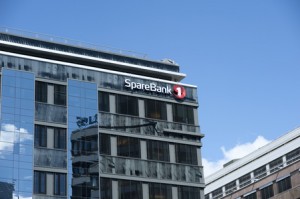SpareBank 1 surprised at subdued demand
Nov 14th, 2013
Demand for a Eu1bn long six year SpareBank 1 covered bond fell short of expectations on Tuesday, and an official at the issuer said the outcome was surprising, with the choice of maturity and amount of recent Nordic supply perhaps explaining the subdued reception.
The January 2020 deal was priced at 15bp over mid-swaps, the middle of guidance of the 15bp over area and initial price thoughts of the mid-teens. Barclays, DZ Bank, HSBC and ING lead managed the Norwegian issuer’s transaction.
 Syndicate bankers away from SpareBank 1’s deal said it was not fully subscribed by end investor demand. The last official update about the level of demand for SpareBank 1’s deal was that some Eu800m of orders had been placed for the deal — the bookrunners did not communicate the size of the final order book.
Syndicate bankers away from SpareBank 1’s deal said it was not fully subscribed by end investor demand. The last official update about the level of demand for SpareBank 1’s deal was that some Eu800m of orders had been placed for the deal — the bookrunners did not communicate the size of the final order book.
Arve Austestad, chief executive of SpareBank 1 Boligkreditt, said that the outcome of the deal was surprising for the issuer and the leads.
“It did not go as we had expected,” he told The Covered Bond Report. “The demand was OK, but not what we were aiming for. The accounts in the book were of high quality, but we wanted a bigger number.”
Some syndicate officials said that the maturity of the deal was to blame for the limited demand, with investor fatigue — of tight spreads and Nordic supply — also cited as contributing factors.
Four of the last six euro benchmark covered bonds have been from Nordic issuers, a series of deals that started with Eu1bn seven year deals for Sweden’s Stadshypotek and SEB three weeks ago before a switch to Norway with a Eu1.5bn five year DNB Boligkreditt issue last Tuesday (5 November). The Swedish deals are said to be bid around their re-offer levels — 9bp for Stadshypotek and 10bp for SEB — with DNB’s transaction having tightened a little from its 7bp re-offer spread to around 5bp over.
SpareBank 1’s Austestad said that the issuer went into the transaction with the understanding that demand in the five to seven year maturity range was good, with the January 2020 maturity having been chosen for asset-liability management reasons.
“In hindsight maybe that was the reason, but there have also been three Nordics in three weeks so that may be one of the main reasons,” he said.
The deal is SpareBank 1’s second euro benchmark this year, with the issuer having planned to return to the market after the summer, according to Austestad.
“It covers our funding requirements for the coming months,” he said.
A syndicate banker away from the leads said that it was the right decision for the leads to take up the slack in demand rather than widen the spread. As a result, the SpareBank 1 deal is unlikely to have a negative wider impact on the market, he suggested, although the next comparable transaction may be approached with a bit more caution as a consequence.
Germany and Austria took 53% of SpareBank 1’s deal, the Nordics 20%, Asia 9%, the UK 8%, the Benelux 7%, Switzerland 2%, and others 1%. Banks were allocated 65%, central banks and official institutions 17%, fund managers 13%, insurance companies 3%, and others 2%.
Syndicate bankers away from the leads had generally not taken issue with the level on SpareBank 1’s deal when it was being marketed on Tuesday morning, although one had said that IPTs of the mid-teens were an aggressive start compared with recent transactions and that this was a “brave” move.
Based on secondary levels, a January 2020 should be around 12bp over mid, putting the bid side at 14bp over, he said. This meant that Sparebank 1 went out with a level close to the bid side, for which the market is not quite yet ready, he suggested.
A lead syndicate banker said that the new issue premium was in line with levels seen on recent transactions, while another said the 15bp over level represented a fair price for the quality of the offering, and a tighter spread would also have been justified based on comparables.
And other syndicate officials away from the leads approved of the spread. One was convinced the choice of maturity was to blame for the subdued demand, calling it a mistake.
“It’s neither fish nor fowl,” he said.
Another said that there has been good demand for recent Nordic covered bonds from bank treasuries stocking up their liquidity buffers for LCR purposes, but that real money accounts are finding levels too tight.
Nordic issuers can still find real money demand in the senior unsecured market, however, said a syndicate banker.
This was the focus for Svenska Handelsbanken on Thursday, with the Swedish issuer tapping the sterling market with a seven year via leads JP Morgan, Lloyds and Nomura. A £400m (Skr4.29bn, Eu478m) deal was set to be priced at 105bp over Gilts, the middle of guidance of 105bp over plus/minus 2bp.
Initial price thoughts were set at the 110bp over area. Orders were approaching £750m, according to an update seen shortly before publication.
The sterling issue comes after a Eu1bn seven year covered bond on 23 October for Handelsbanken’s subsidiary Stadshypotek, which kickstarted a small wave of Nordic euro benchmark covered bond supply. Handelsbanken sold a $2.5bn dual tranche senior unsecured bond in the middle of September, after having been active in euros, sterling and Swiss francs during a busy two week period in August.








